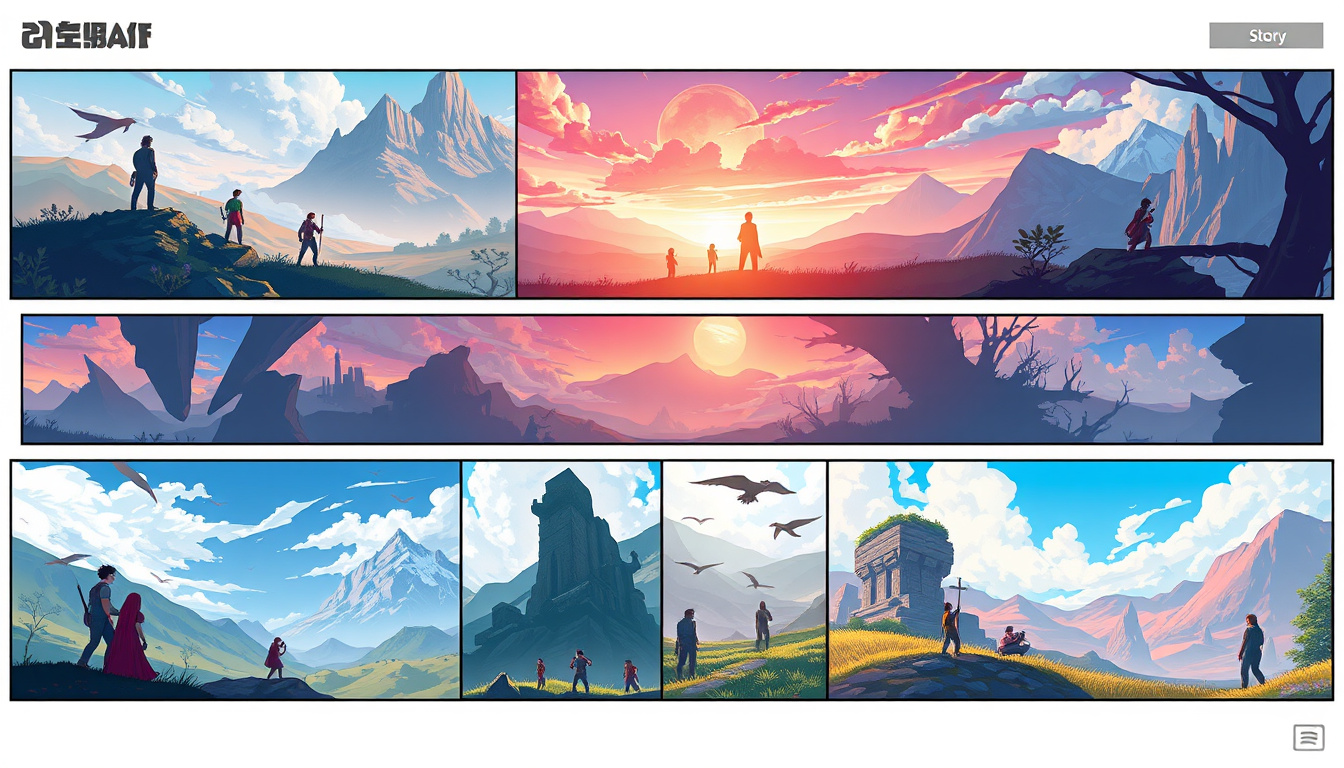
Welcome to the Whimsical World of Screenwriting!
So, you want to be the puppet master of a plot, the architect of dialogue, and the crafter of characters that could leap off the page? Welcome to the art of screenwriting, where every page you write has the potential to turn into cinematic gold! Screenwriting is the backbone of films and television, imbuing stark images with life and voices. It’s a craft, nay, a superpower, that allows writers to weave compelling narratives that captivate audiences, pound heartbeats, and even change minds.
But wait, there’s more! Mastering the art of screenwriting isn’t just about penning down a few catchy dialogues or creating memorable characters – it’s about opening a plethora of doors to new worlds. Whether you dream of seeing your work on the silver screen, the glowing boxes in living rooms, or even the handheld streaming devices, knowing your way around a screenplay is your ticket in. Ready to dive into the nitty-gritty of nut-bolting a blockbuster or stitching the seams of a sitcom? Here’s how you can turn those sparks of imagination into scriptwriting splendor!
Chapter One: The Fundamentals of Good Screenwriting
It’s easy to think that writing a script is as simple as putting pen to paper and letting the dialogues flow. However, the foundation of any gripping screenplay is a robust structure, the beloved three-act framework, which structures your narrative into a setup, confrontation, and resolution. Dive deep into character arcs that make your heroes and villains irresistible. And dialogue? Let’s whip up conversations so real that your audience checks their phones to make sure they aren’t receiving those texts!
Screenplays thrive on conflict. After all, nobody wants to watch paint dry unless it’s narrated with nail-biting suspense. Conflict is the engine of your story, driving the plot forward faster than a sports car in a high-octane chase scene. Want in on more screenwriting secrets? Buckle up, as we elevate your script from ‘just another draft’ to ‘red carpet ready’!
From wrinkles that need ironing in your first drafts to navigating the tumultuous oceans of feedback, from genre conventions to pitching your passion project–this witty encyclopedia of screenwriting tips will guide you every step of the way. Prepare to laugh, cry (just a little) and most importantly, learn how to capture the hearts and attention spans of audiences worldwide.
So grab your keyboard, some snacks (because let’s face it, writing is hungry work), and ready your mind for a tour through the mesmerizing maze of screenwriting. And remember, in the realm of screenplay writing, the pen isn’t just mightier than the sword; it’s mightier than the camera, the lights, and the action too!
Introduction to Screenwriting
What exactly is screenwriting, you ask? Imagine being the architect of a universe where characters live and breathe at the stroke of your pen (or more accurately, the clacking of your keyboard). That, my dear reader, is the essence of screenwriting. It’s the art of crafting scripts for films, television shows, and other forms of media that tell a story. Unlike the novelists who leisurely paint their canvases with broad descriptive strokes, screenwriters must master the economy of words, designing dialogues and scenes that can be transformed into visual spectacles.
Now, you might think, Why bother with screenwriting? Well, hold on to your popcorn, because screenwriting is not just about putting words on a page; it’s a passport to the pulsating heart of the entertainment industry. Each script is a blueprint for a new world waiting to be explored by eager audiences. Whether it’s a blockbuster movie, a binge-worthy TV series, or even a captivating web series, screenwriting is at its core.
But here’s the scoop: screenwriting is also about opening doors. Doors to exploring profound human emotions, doors to creating iconic characters (ever heard of a chap named James Bond or that wizard kid, Harry Potter?), and yes, doors to thrilling career opportunities across the globe. Mastering the craft of screenwriting allows you to weave narratives that not only entertain but resonate deeply with diverse audiences.
So, as we set the stage in this guide, gear up for an adventure into the world of screenwriting. Whether you aspire to captivate hearts through indie films or aim to pen the next big sci-fi series, understanding the mechanics and nuances of screenwriting is your first step. And who knows? This might just be the beginning of your storybook journey in the labyrinth of the film and television industry.
With that, let’s flick through the pages of what will essentially serve as your map and compass in the vast, thrilling universe of screenwriting. Ready your scripts, and may the force of creativity be with you!
Fundamental Techniques in Screenwriting
Welcome, young script wizards and word charmers! Prepare to dive into the cauldron of creativity known as screenwriting, where the potion of successful storytelling is brewed. Let’s unlock the secrets of enchanting your audience!
The Backbone of Your Tale: Understanding Structure
First and foremost, let’s tackle the skeleton of any screenplay: the structure. Picture it as the backbone of your story, keeping everything upright and orderly. Most tales you adore likely follow the classic three-act structure, an invincible framework that has weathered the storms of cinematic history. Think of Act One as the appetizer, setting the stage and whetting the appetite with your setting and characters. Act Two, the main course, serves up hefty portions of conflict and challenges, pushing characters to their limits. Finally, Act Three is the dessert, rewarding us with resolutions and, hopefully, a satisfying aftertaste.
But why stick to vanilla when there are so many flavors to explore? Feel free to play with this structure, rearrange it like a Rubik’s Cube, but always ensure each piece clicks into place, maintaining a clear narrative flow. The audience might enjoy a twisty puzzle, but no one likes being lost in a labyrinth without a clue.
Creating Characters That Walk Off The Page
One cannot discuss screenwriting without tipping the hat to the art of character development. After all, what’s a story without its heroes and villains? To forge characters that resonate, think beyond the surface. These aren’t just names on a page; they are potential friends, foes, and even frenemies to your audience. Start with their desires, fears, and secrets. What makes their heart race like a high-speed chase scene? What’s their Achilles’ heel?
Create a character biography, throw them into hypothetical situations and see how they react. Would your stoic hero dance in the rain? Does your villain have a soft spot for old jazz records? These nuances make them relatable and memorable. Remember, sometimes a character whispering a heartfelt monologue can be more powerful than a thousand explosions.
The Art of Dialogue: Speaking Volumes with Words
Dialogue in screenwriting isn’t just about filling the silence; it’s about revealing truth and moving the narrative forward. Write dialogue that sizzles, that holds weight like a shopper balancing baskets on Black Friday. Let your characters speak like real people, not as narrators of their own stories. Avoid exposition dumps—nobody likes a chatty Cathy explaining every detail of the plot. Instead, use dialogue to expose character flaws, dreams, and conflicts. Imagine dialogue as a tango between what is said and what is meant, always leaving room for the delicious tension of subtext.
Conflict: The Engine of Your Story
Conflict is the jet fuel of any screenplay. Without it, your story is a fancy car with an empty tank, going nowhere. Conflict comes in many flavors: man vs. society, man vs. nature, man vs. a vending machine that swallowed his dollar—each can be compelling if it deeply affects your characters. The key? Ensure the conflict grows from the characters’ unique worldviews and desires. This is what propels the story forward, gluing your audience to their seats, popcorn forgotten. Whether it’s internal turmoil or external battles, these conflicts must challenge your characters, forcing them to evolve or revealing their true colors.
Screenwriting, my dear readers, is not just about stringing words together; it’s about orchestrating an emotional symphony with structure, character, dialogue, and conflict as your instruments. Master these elements, and you hold the power to not just tell a story, but to create worlds that linger in the hearts and minds long after the credits roll. Now go forth, weave your narratives with passion, and perhaps, mischief too. After all, what’s a good story without a little mischief?
Advanced Tips for Aspiring Screenwriters
If you’ve mastered the mystical basics of screenwriting, pat yourself on the back, but don’t throw your quill down just yet! As you climb the treacherous slopes of Mount Hollywood or traipse through the dense jungles of indie filmmaking, there’s a veritable smorgasbord of advanced insights and tricks to help you refine your scriptwriting saber. Let’s dive into these with the verve of a caffeinated playwright at midnight.
Mastering the Mosaic of Genres
Ah, genres! They’re like different ice cream flavors, and knowing your strawberry from your pistachio can make all the difference. Understanding genre conventions isn’t just about sticking to rules—it’s about knowing how to bend them to your creative will. If horror is your jam, throw in an unexpected twist of humor to keep your audience on their toes. Or if romance tickles your fancy, why not sprinkle a pinch of sci-fi? Remember, it’s your story; add the spices you love!
Making the Most of Feedback and Revisions
Feedback—the word alone can send shivers down the spine of the staunchest scribe. Yet, embracing criticism is like eating your screenwriting vegetables: not always pleasant, but oh-so-nourishing. Learn to distinguish between constructive critiques and mere naysaying. Nurture a circle of trusted advisors who understand your vision yet aren’t afraid to challenge you. And always revise with a scalpel—trim the fat, sharpen the dialogue, and polish that plot until it shines like the top of the Chrysler Building!
Conquering the Beast of Writer’s Block
Even the most prolific of pen wielders can hit the wall. Writer’s block doesn’t have to be a showstopper; treat it as a pit stop. When inspiration plays hard to get, switch up your routine. Write in a new location, switch from laptop to good old pen and paper, or chat with a fellow wordsmith over coffee about nothing in particular. Sometimes, the best ideas sneak in through the back door when you’re busy looking out the front.
The Power of Workshops and Networking
Think of workshops as your screenwriting gym—places to flex those creative muscles and sweat out the clichés. Being a part of a community gives you not just feedback and support, but also plugs you into the grapevine of opportunities—script readings, co-writing ventures, and yes, even those elusive industry parties. Networking isn’t a dirty word; it’s the golden key that might just open the right door at the right time. So polish your social skills along with your scripts!
Lifelong Learning as a Lifestyle
In the world of screenwriting, graduation day is never really in sight, and that’s thrilling. Keep your intellectual curiosity thriving by attending talks, reading extensively, not just screenplays, but books on psychology, history, science—anything that adds depth to your storytelling. And watch movies, a lot of movies. Dissect them, understand what works, what doesn’t, and keep a keen eye on character arcs and plot pacing.
The Art of Adaptation
Adapting a beloved book or a historical event offers its own set of thrilling challenges. Here’s where your respect for source material tempers with your rebellious streak to innovate. Keep the essence, tweak the structure, and remember, sometimes what works in a novel won’t gel on screen. Your job isn’t just to convert but to transform, to transport a story from one medium to another while keeping its soul intact.
Selling Your Screenplay: Not for the Faint of Heart
Last but certainly not least, the final boss battle—selling that screenplay. It’s part Sherlockian deduction, part Don Draper’s charm. Know your market, craft a compelling query letter, and pitch like you’re Spielberg selling Jaws. And remember, rejection is just redirection. Keep refining, keep networking, and keep the passion blazing.
So, whether you’re weaving through a psychological thriller or sketching the next blockbuster romance, armed with these advanced screenwriting strategies, you’re closer than ever to not just mastering the craft but potentially rewriting the rules of the cinematic game itself.
Grabbing the Final Draft by the Horns!
Well, well, well, aspiring screenwriters! You’ve trotted through the playground of plots and dived deep into the ocean of dialogues, but as all good screenplays have a satisfying end, so must our enlightening exploration. Now that you’ve armed yourself with the crème de la crème of screenwriting wisdom—from the bone structure of the three-act delight to the spicy salsa of character development—it’s nearly showtime! But remember, the scriptwriter’s journey is peppered with both applause and crickets, and like any classic hero, your quest only truly ends at ‘The End.’
The Encore
Before you go off-script and jump into the arena, let’s dim the lights and spotlight the essentials one more time. Structure, character, and dialogue are your trusty sidekicks in this narrative. Cling to them, and when in doubt, always, always, let conflict drive your screenplay bus. You’ve learned to dance through genres and jive with revisions—so keep those feet tapping. Every comma, every cut, every cry of “Why won’t this character behave as I write them to?!” is a step towards your masterpiece.
The Grand Finale
Stand up, dear writer, take a breath, and prepare to take a bow. Harness every piece of advice, every technique, and remember, the screenwriting world is your stage. It’s yours to charm and change, one scene at a time. Keep your fingers poised on the keyboard and your heart ready for rewrites. The path to screenwriting stardom is rarely straight but always rewarding. So, here’s to late-night edits, early-morning inspirations, and all the caffeinated beverages in between. Action!






